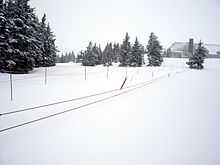Ski tow

A ski tow, also called rope tow, handle tow, or bugel lift, is a mechanised system for pulling skiers and snowboarders uphill.
In its most basic form, it consists of a long rope loop running through a bullwheel (pulley) at the bottom and one at the top, powered by an engine at one end. Passengers grab hold of the rope and are pulled along while standing on their skis or snowboards and sliding up the hill, with some variations having simple fixed handles. These simple forms remain popular for the relatively flat portions of ski areas devoted to beginners—often called bunny slopes—but are increasingly being replaced by magic carpets.
The more advanced form uses a series of pulleys to follow the slope, and can be up to 1.4 km long tow with a 600 metre vertical rise. The forces involved and the pulleys which the rope passes through require the rider to attach using a "nutcracker" or "tow grabber". This style has now been superseded by T-bar lifts, platter lift and chairlift in most places—with the notable exception of the smaller club fields of New Zealand.
History
The first ski tow was invented 1908 in the Black Forest, Germany by Robert Winterhalder.[1] The first one in North America was apparently installed in 1933 by Alec Foster at Shawbridge in the Laurentians outside Montreal, Quebec.[2]
It was quickly copied at Woodstock, Vermont in New England in 1934 by Bob and Betty Royce, proprietors of the White Cupboard Inn. Their tow was driven by the rear wheel of a Ford Model A. Wallace "Bunny" Bertram took it over for the second season, improved the operation, renamed it from Ski-Way to Ski Tow,[3] and eventually moved it to what became the eastern fringe of Vermont's major southern ski areas, a regional resort still operating today as Suicide Six. Their relative simplicity—a car engine, some rope and a few pulleys were all that was needed—made ski tows widespread and contributed to an explosion of the sport in the United States and Europe. Before tows, only people willing to walk uphill could ski. Suddenly, relatively unathletic people could participate, greatly increasing the appeal of the sport. Within five years, more than 100 tow ropes were operating in North America.[4]
Rope tows

Simple rope tows used without a nutcracker are limited in distance because they cannot have intermediate supports, and the grade of a rope tow is largely limited by passenger grip strength.
Another style is identical to the basic tow rope, but a number of approximately 1 foot metal handles are attached firmly to the rope. The user grabs these handles and never has to touch the actual rope. The advantages compared to a basic rope is the metal bars are easier to grab, eliminate the possibility of rope burn, and the handle can be held in front of the user (as opposed to holding the rope at the user's side). This style of ski tow is known as a pony lift in some areas.
Nutcrackers

In 1939 the "tow grabber" or nutcracker was invented,[5] allowing faster speeds and steeper slopes. and were widely used on many fields in the 1940s, but are now largely restricted to small club fields. The rope tow design, including the nutcracker device, was further developed by William Hamilton (of Hamilton jet fame) in the 1950s which may explain the continuing popularity of these devices in New Zealand.
The rider wears a harness around the hips.[6] To this is attached a clamp, much like the nutcracker from which it derives its name, which the rider attaches to the rope. This eliminates the need to hold on with the hands, reducing fatigue and allowing faster tows. The nutcracker device is essential on longer and steeper tows, as the rope runs over pulleys[7] to keep it off the ground.[8]
In the United States they are still used at Meany Lodge in Washington state,[9] and Mount Greylock Ski Club in Massachusetts.[10] In Australia almost all ski resorts began with nutcracker tows, but they are now confined to a few isolated ski lodges on the mainland, except for the Mount Mawson "club field" near Hobart which boasts four nutcracker tows.[11]
In New Zealand, rope tows with nutcrackers epitomize the rugged, 'back to basics' character of club skifields and the nutcracker remains the norm at club fields such as Tukino, Maunganui, Mt Lyford, Hanmer Springs, Temple Basin, Broken River, Craigieburn, Fox Peak, Mt Olympus and Awakino. The commercial Roundhill added a rope tow for the 2010 season,[12] and the boutique commercial Invincible Snowfields has only a single rope tow[13][14]
See also
| Wikimedia Commons has media related to Ski tow. |
References
- ↑ Official site of Eisenbach German site with information on Robert Winterhalder's ski tow
- ↑ ISHA resources Timeline of Important Ski History Dates
- ↑ Jeremy Davis. "The History of Vermont Skiing: One Hundred Years of Growth". Archived from the original on 2006-10-17. Retrieved 2006-11-16.
- ↑ http://www.knowledgerush.com/kr/encyclopedia/Ski_tow/
- ↑
- ↑ Bousquet Tow Gripper
- ↑ "riding the nutcracker rope tow..." - video showing why a nutcracker is used
- ↑ License to Chill. Multi Mountain Pass
- ↑ Meany Lodge
- ↑ Mount Greylock Ski Club
- ↑ Australian ski lift directory, section 11 Mt Mawson
- ↑ "New big mountain skiing experience at Roundhill"
- ↑ Non resort rope tows - WikiSki
- ↑ Club skiing in NZ - WikiSki
External links
| ||||||||||||||||
